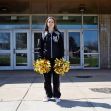It started when a teenager posted a Snapchat filled with swearwords. She lost her spot on the cheerleading squad, her parents sued, and four years later, the U.S. Supreme Court heard arguments that could lead to a new test defining the First Amendment rights of public school students who use social media off-campus.
Throughout the two-hour session, the justices struggled to find and define the parameters of how much free speech students should have, where they should have it, what can it be about, and how much potential harm a school should be allowed to tolerate before censoring or punishing.
These issues were before the court in Mahanoy Area School District v. B.L., the cheerleader case they heard on April 28. It involved a student whose coach removed her from the team because of her social media post that featured her with her middle fingers raised and a caption that said, “F--- school f--- softball f--- cheer f--- everything…” B.L, the school claims, waived her free speech rights when she agreed to team rules.
The rule she allegedly violated stated, “Please have respect for your school, coaches, teachers, other cheerleaders and teams. Remember, you are representing your school when at games, fundraisers, and other events. Good sportsmanship will be enforced; this includes foul language and inappropriate gestures.” Petitioners argue this rule permits an “extra degree of regulation.”
A brief review of current precedents is useful to understand the issues and the justices’ questions. Currently, the most cited precedent is Tinker v. Des Moines School District, a 1969 case involving students’ right to wear black armbands to school to protest the Viet Nam War. In that case, the court said that students “do not shed their constitutional rights at the schoolhouse gate,” except if that speech “would materially and substantially interfere with the requirements of appropriate discipline in the operation of the school.”
Snyder v. Blue Mountain School District is a 2011 case about a student who was suspended for creating a profane and defamatory profile of her principal. Snyder added that without meeting the Tinker test, student speech “must answer to the same constitutional commands that bind all other institutions of government.” Another exception came in 2007 when a student held up a banner saying “Bong Hits 4 Jesus.” In that case, the Court held that schools may “restrict student expression that they reasonably regard as promoting illegal drug use.
These cases show that narrow limitations on student free speech in schools can exist. But none of them have the fact pattern that was before the court in B.L.’s case.
In her arguments petitioner’s attorney Lisa L. Blatt began by discussing whether off-campus speech can be regulated. She said it could because, under Tinker, off-campus speech can cause on-campus disruption, upholding the Third Circuit’s tolerance of BL’s speech would create “chaos,” and Tinker already guards against abuse.
Chief Justice Roberts asked how schools would handle political speech. Blatt replied that to be regulated, the audience must be the school and the topic has to be about school or the speech must be disruptive under the Tinker test. Justice Thomas was also concerned about allowing on-campus speech on “hot button issues” such as Black Lives Matter. Blatt said, “Schools are not in the business of teaching kids what to think.” She said a Confederate flag alone communicates nothing, but “if you take that speech and terrorize a black student with it,” that would cross the line.
Justice Breyer asked where she found evidence that B.L.’s swearing caused a material and substantial disruption. “And if swearing off-campus did, I mean, my goodness, every school in the country would be doing nothing but punishing students.” Justice Alito asked what would happen if political speech does cause disruption. Blatt explained that line is between somebody taking offense and an “actual objective interference with their ability to educate.” A discussion about a school’s right to censor bullying followed, and Blatt said that schools must follow anti-bullying rules that already exist in all 50 states.
Justice Sotomayor then opened a door that led to much discussion. Do students on athletic teams or in extracurricular activities lose some of their free speech rights? The Third Circuit had ruled that the “contract” B.L .signed when she joined the squad was not violated.
Justice Kagan turned to free speech on t-shirts. What happens, for example, if a student wears a t-shirt that says “Abortion is Murder”? Blatt said that would be allowed unless it “terrorizes” a particular student. The word “terrorize,” Blatt noted, is a higher standard than “offend.’ Justice Gorsuch asked her to give examples of unpermitted speech. Blatt responded that would be speech that incited race riots, gang fights and student walkouts.
Justice Kavanaugh, who himself coached his daughter’s team, thought a year’s suspension was “a bit of an overreaction by the coach.” He asked Blatt, “your approach would be to just say the Tinker standard applies regardless of the…precise location of the speech and just remand? Is that enough?” Blatt replied, “That's absolutely enough.” Justice Barret asked whether Blatt saw anything that required the extension of Tinker to “outside the school environment.” Blatt concluded “Students shouldn't be able to place their speech off-limits just by stepping off campus.”
Malcolm L. Stewart, Deputy Solicitor General, spoke as amicus curiae supporting the petitioner. He told the justices that he agreed team members could be treated differently and argued that there is “no per se rule that off-campus speech is categorically exempt from school regulation.”
The respondent was represented by David D. Cole. He began by explaining that the Third Circuit decided that Tinker didn’t apply to B.L.’s situation. But, he explained, it included a separate section on whether schools can impose conditions on “voluntary participation” in activities such as sports teams. He concluded, “Expanding Tinker would transform a limited exception into a 24/7 rule that would upend the First Amendment's bedrock principle and would require students to effectively carry the schoolhouse on their backs in terms of speech rights everywhere they go. It would also directly interfere with parents' fundamental rights to raise their children… B.L. was punished for merely expressing frustration with a four-letter word to her friends outside of school on a weekend. Her message may seem trivial, but, for young people, the ability to voice their emotions to friends without fear of school censorship may be the most important freedom of all.”
His answers to questions by the justices reiterated the scope of Tinker, stressing, “In school, you can apply Tinker. Out of school, you can't.”
In his summary, Cole listed the choices before the Court as it decides this case. It could go broad or narrow. It could dismiss the case, or say Tinker applies only in school and ignore what happens outside of school. It could ignore bullying and let other statutes address it. Or it could decide whether teams have more leeway to regulate the on- and off-campus behavior of those who agree to participate. Or it could fashion an entirely new rule that would regulate student speech in what the Third Circuit called the “new frontier” of social media.
There are so many possibilities, and it is clear the justices will struggle to define the parameters that B.L. and her foul-written rant created.






